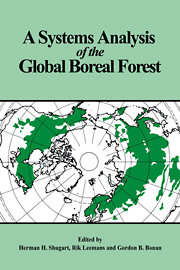Book contents
- Frontmatter
- Contents
- List of contributors
- 1 Introduction
- Part 1 Processes in boreal forests
- Introduction
- 2 Silvics of the circumpolar boreal forest tree species
- 3 The reproductive process in boreal forest trees
- 4 Soil temperature as an ecological factor in boreal forests
- 5 Fire as a controlling process in the North American boreal forest
- 6 The role of forest insects in structuring the boreal landscape
- Part 2 Patterns in space and time in boreal forests
- Part 3 Computer models for synthesis of pattern and process in the boreal forest
- References
- Index
4 - Soil temperature as an ecological factor in boreal forests
Published online by Cambridge University Press: 12 January 2010
- Frontmatter
- Contents
- List of contributors
- 1 Introduction
- Part 1 Processes in boreal forests
- Introduction
- 2 Silvics of the circumpolar boreal forest tree species
- 3 The reproductive process in boreal forest trees
- 4 Soil temperature as an ecological factor in boreal forests
- 5 Fire as a controlling process in the North American boreal forest
- 6 The role of forest insects in structuring the boreal landscape
- Part 2 Patterns in space and time in boreal forests
- Part 3 Computer models for synthesis of pattern and process in the boreal forest
- References
- Index
Summary
Introduction
The circumpolar boreal forest landscape reflects a combination of factors unique to high-latitude environments. A short growing season, strong seasonal fluctuations in air temperature and day length, low solar elevation angles, cold soil temperature, the presence of permafrost, poorly-drained soils, a thick forest floor, low nutrient availability, and recurring forest fires are thought to interact to produce the wide range in stand productivity characteristic of boreal forests (Bonan & Shugart 1989). Low soil temperatures and permafrost are perhaps the factors most unique to high-latitude environments. In this chapter, I examine the role of soil temperature and permafrost as ecological factors in the boreal forest.
Environmental controls of soil temperature and permafrost
Over 50% of Canada and the Soviet Union are underlain by permafrost, that is, the thermal condition of soil when its temperature remains below 0°C continuously for two years or more (Brown 1969, 1970; Brown & Pewe 1973). The existence of permafrost is the result of the historical and current state of the surface energy balance and geothermal heat flow (Lunardini 1981). Even if present energy conditions are not conducive to the formation of permafrost, it may still exist as relic permafrost if past conditions have been favorable. However, the current dynamics of permafrost depends on the current surface energy balance, which primarily reflects air temperature as modified to a secondary degree by solar radiation, vegetation, snow cover, and soil characteristics (Brown 1970; Lunardini 1981; Rieger 1983).
Air temperature and solar radiation are correlated with the heat load received on a surface. In Canada, the southern limit of permafrost corresponds with the −1.1°C mean annual air temperature isotherm (Brown 1969).
- Type
- Chapter
- Information
- A Systems Analysis of the Global Boreal Forest , pp. 126 - 143Publisher: Cambridge University PressPrint publication year: 1992
- 35
- Cited by



